Critical Analysis of Health and Stress: Coursework Essay
VerifiedAdded on 2022/08/13
|6
|1637
|10
Essay
AI Summary
This essay provides a critical analysis of the multifaceted relationship between health and stress. It defines health as encompassing mental, physical, and social well-being, emphasizing that it's not merely the absence of disease but a holistic state. The essay explores how personal thoughts, emotions, and past experiences, including traumatic events, significantly impact health, potentially leading to chronic diseases. It delves into the perception of pain, highlighting the roles of both biological and psychological factors, such as anxiety and depression. Furthermore, the essay examines various sources of stress, including response-based, stimulus-based, and cognitive-transactional approaches, and discusses effective stress management techniques. It underscores the importance of mental health awareness, patient-physician communication, and proactive coping strategies to mitigate the adverse effects of stress and past experiences on overall health and well-being. The essay emphasizes the importance of a healthy lifestyle and encourages seeking professional help when needed.
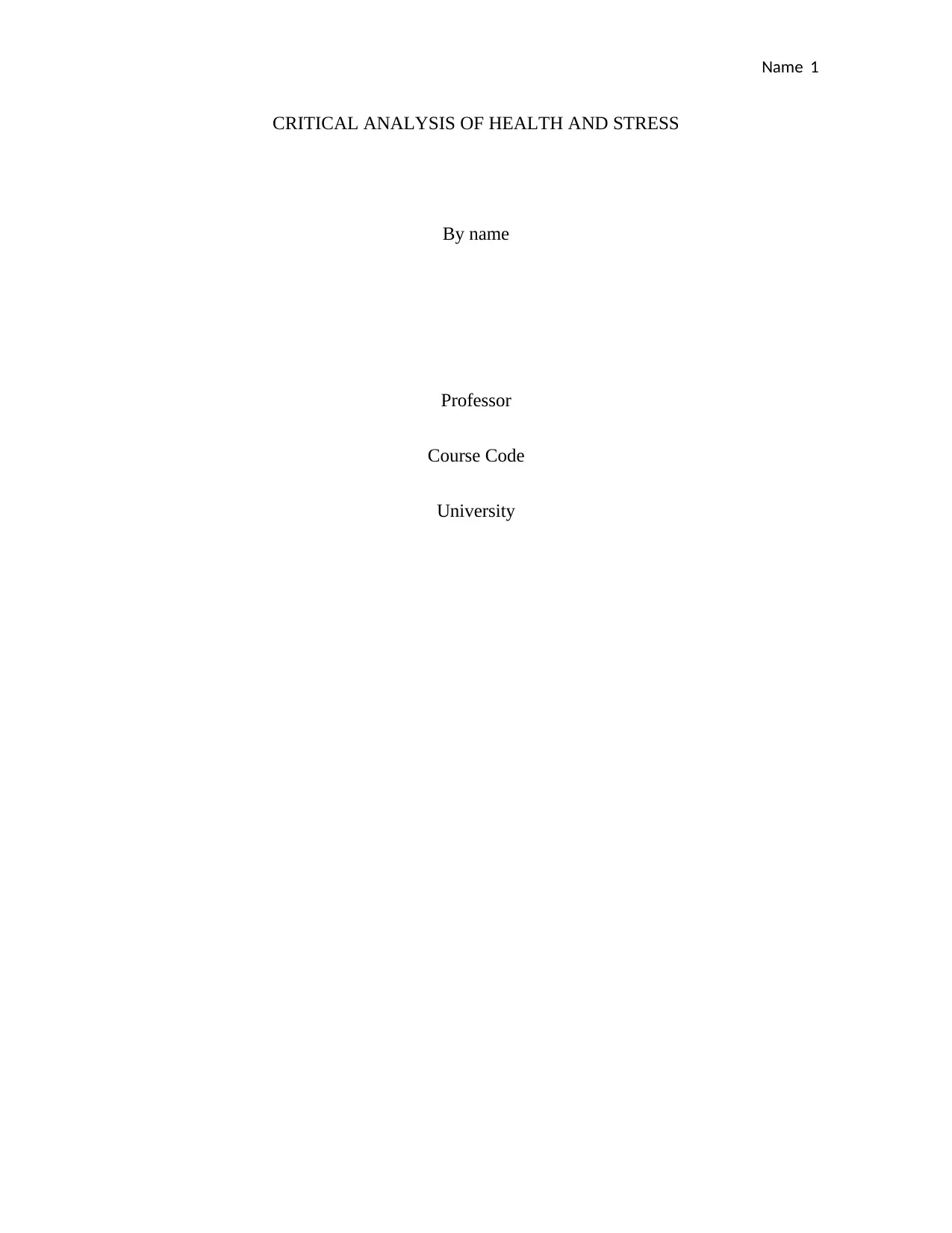
Name 1
CRITICAL ANALYSIS OF HEALTH AND STRESS
By name
Professor
Course Code
University
CRITICAL ANALYSIS OF HEALTH AND STRESS
By name
Professor
Course Code
University
Paraphrase This Document
Need a fresh take? Get an instant paraphrase of this document with our AI Paraphraser
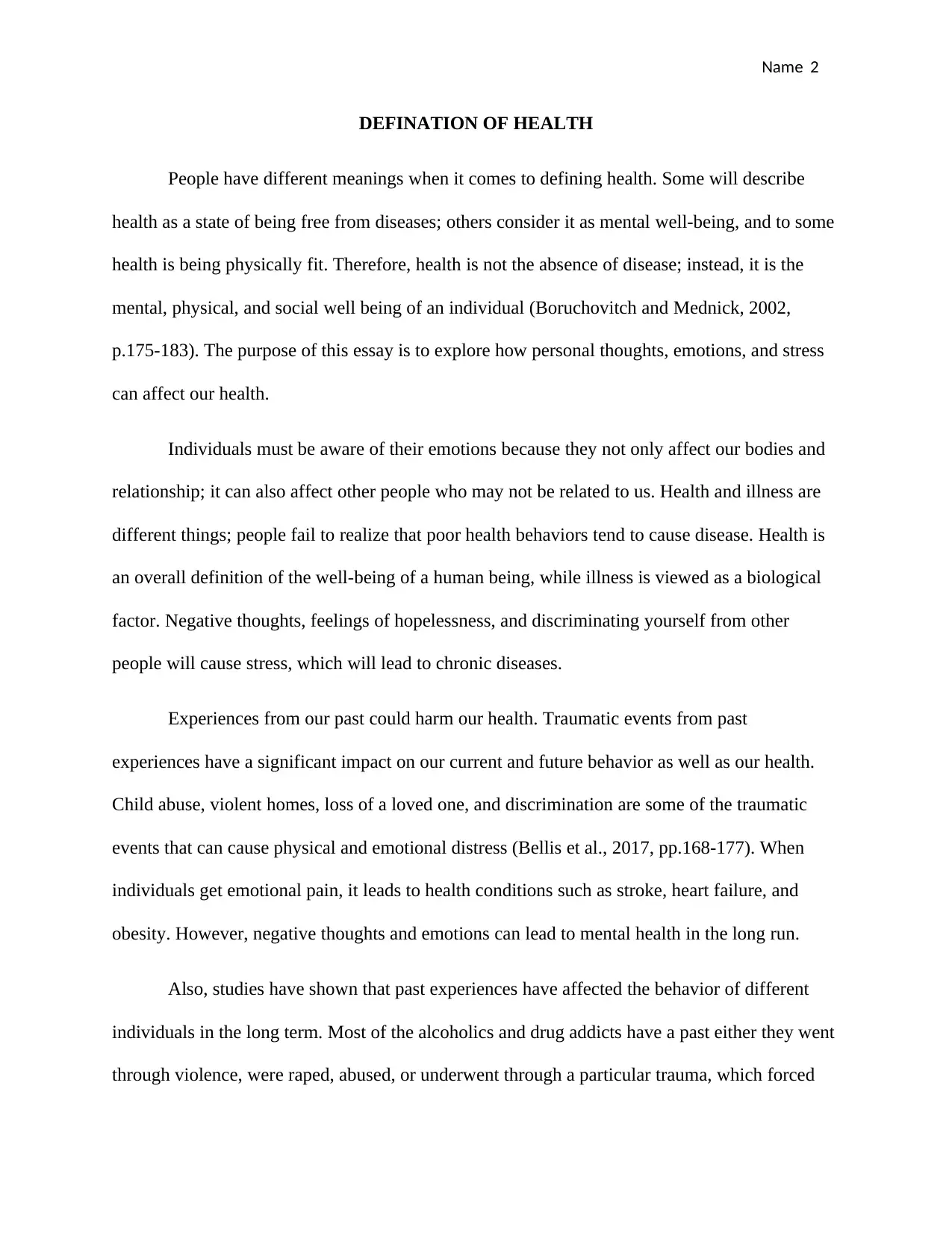
Name 2
DEFINATION OF HEALTH
People have different meanings when it comes to defining health. Some will describe
health as a state of being free from diseases; others consider it as mental well-being, and to some
health is being physically fit. Therefore, health is not the absence of disease; instead, it is the
mental, physical, and social well being of an individual (Boruchovitch and Mednick, 2002,
p.175-183). The purpose of this essay is to explore how personal thoughts, emotions, and stress
can affect our health.
Individuals must be aware of their emotions because they not only affect our bodies and
relationship; it can also affect other people who may not be related to us. Health and illness are
different things; people fail to realize that poor health behaviors tend to cause disease. Health is
an overall definition of the well-being of a human being, while illness is viewed as a biological
factor. Negative thoughts, feelings of hopelessness, and discriminating yourself from other
people will cause stress, which will lead to chronic diseases.
Experiences from our past could harm our health. Traumatic events from past
experiences have a significant impact on our current and future behavior as well as our health.
Child abuse, violent homes, loss of a loved one, and discrimination are some of the traumatic
events that can cause physical and emotional distress (Bellis et al., 2017, pp.168-177). When
individuals get emotional pain, it leads to health conditions such as stroke, heart failure, and
obesity. However, negative thoughts and emotions can lead to mental health in the long run.
Also, studies have shown that past experiences have affected the behavior of different
individuals in the long term. Most of the alcoholics and drug addicts have a past either they went
through violence, were raped, abused, or underwent through a particular trauma, which forced
DEFINATION OF HEALTH
People have different meanings when it comes to defining health. Some will describe
health as a state of being free from diseases; others consider it as mental well-being, and to some
health is being physically fit. Therefore, health is not the absence of disease; instead, it is the
mental, physical, and social well being of an individual (Boruchovitch and Mednick, 2002,
p.175-183). The purpose of this essay is to explore how personal thoughts, emotions, and stress
can affect our health.
Individuals must be aware of their emotions because they not only affect our bodies and
relationship; it can also affect other people who may not be related to us. Health and illness are
different things; people fail to realize that poor health behaviors tend to cause disease. Health is
an overall definition of the well-being of a human being, while illness is viewed as a biological
factor. Negative thoughts, feelings of hopelessness, and discriminating yourself from other
people will cause stress, which will lead to chronic diseases.
Experiences from our past could harm our health. Traumatic events from past
experiences have a significant impact on our current and future behavior as well as our health.
Child abuse, violent homes, loss of a loved one, and discrimination are some of the traumatic
events that can cause physical and emotional distress (Bellis et al., 2017, pp.168-177). When
individuals get emotional pain, it leads to health conditions such as stroke, heart failure, and
obesity. However, negative thoughts and emotions can lead to mental health in the long run.
Also, studies have shown that past experiences have affected the behavior of different
individuals in the long term. Most of the alcoholics and drug addicts have a past either they went
through violence, were raped, abused, or underwent through a particular trauma, which forced
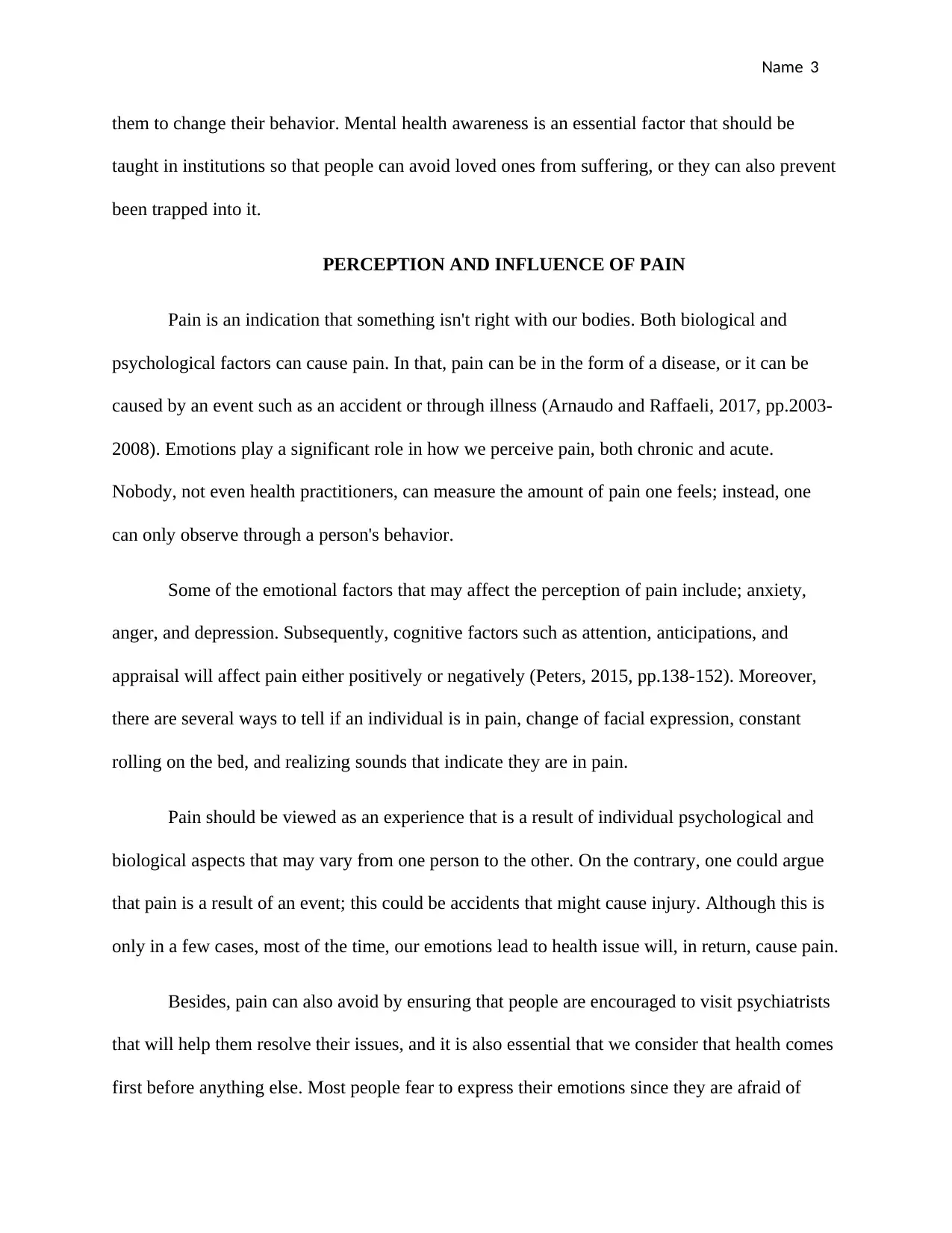
Name 3
them to change their behavior. Mental health awareness is an essential factor that should be
taught in institutions so that people can avoid loved ones from suffering, or they can also prevent
been trapped into it.
PERCEPTION AND INFLUENCE OF PAIN
Pain is an indication that something isn't right with our bodies. Both biological and
psychological factors can cause pain. In that, pain can be in the form of a disease, or it can be
caused by an event such as an accident or through illness (Arnaudo and Raffaeli, 2017, pp.2003-
2008). Emotions play a significant role in how we perceive pain, both chronic and acute.
Nobody, not even health practitioners, can measure the amount of pain one feels; instead, one
can only observe through a person's behavior.
Some of the emotional factors that may affect the perception of pain include; anxiety,
anger, and depression. Subsequently, cognitive factors such as attention, anticipations, and
appraisal will affect pain either positively or negatively (Peters, 2015, pp.138-152). Moreover,
there are several ways to tell if an individual is in pain, change of facial expression, constant
rolling on the bed, and realizing sounds that indicate they are in pain.
Pain should be viewed as an experience that is a result of individual psychological and
biological aspects that may vary from one person to the other. On the contrary, one could argue
that pain is a result of an event; this could be accidents that might cause injury. Although this is
only in a few cases, most of the time, our emotions lead to health issue will, in return, cause pain.
Besides, pain can also avoid by ensuring that people are encouraged to visit psychiatrists
that will help them resolve their issues, and it is also essential that we consider that health comes
first before anything else. Most people fear to express their emotions since they are afraid of
them to change their behavior. Mental health awareness is an essential factor that should be
taught in institutions so that people can avoid loved ones from suffering, or they can also prevent
been trapped into it.
PERCEPTION AND INFLUENCE OF PAIN
Pain is an indication that something isn't right with our bodies. Both biological and
psychological factors can cause pain. In that, pain can be in the form of a disease, or it can be
caused by an event such as an accident or through illness (Arnaudo and Raffaeli, 2017, pp.2003-
2008). Emotions play a significant role in how we perceive pain, both chronic and acute.
Nobody, not even health practitioners, can measure the amount of pain one feels; instead, one
can only observe through a person's behavior.
Some of the emotional factors that may affect the perception of pain include; anxiety,
anger, and depression. Subsequently, cognitive factors such as attention, anticipations, and
appraisal will affect pain either positively or negatively (Peters, 2015, pp.138-152). Moreover,
there are several ways to tell if an individual is in pain, change of facial expression, constant
rolling on the bed, and realizing sounds that indicate they are in pain.
Pain should be viewed as an experience that is a result of individual psychological and
biological aspects that may vary from one person to the other. On the contrary, one could argue
that pain is a result of an event; this could be accidents that might cause injury. Although this is
only in a few cases, most of the time, our emotions lead to health issue will, in return, cause pain.
Besides, pain can also avoid by ensuring that people are encouraged to visit psychiatrists
that will help them resolve their issues, and it is also essential that we consider that health comes
first before anything else. Most people fear to express their emotions since they are afraid of
⊘ This is a preview!⊘
Do you want full access?
Subscribe today to unlock all pages.

Trusted by 1+ million students worldwide
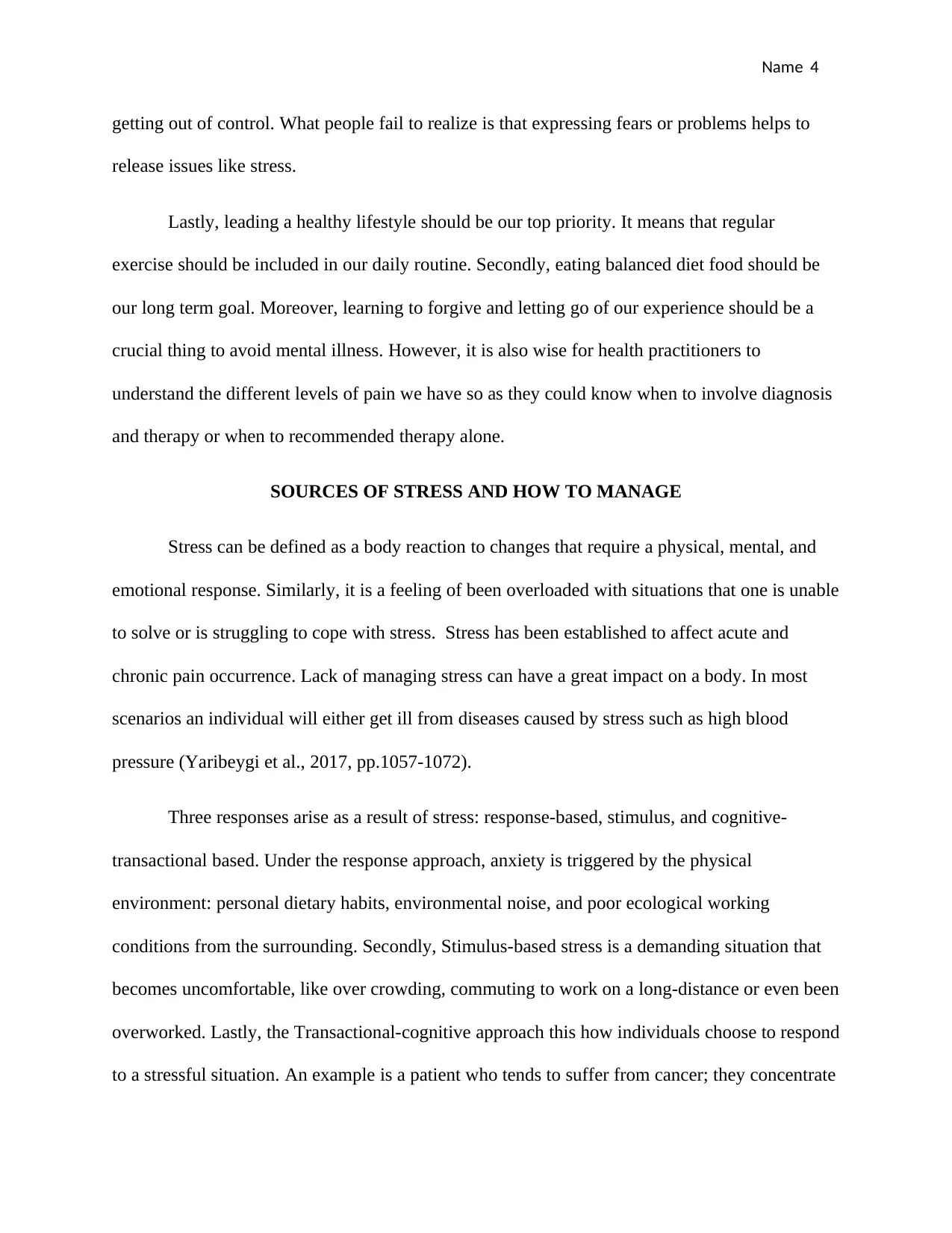
Name 4
getting out of control. What people fail to realize is that expressing fears or problems helps to
release issues like stress.
Lastly, leading a healthy lifestyle should be our top priority. It means that regular
exercise should be included in our daily routine. Secondly, eating balanced diet food should be
our long term goal. Moreover, learning to forgive and letting go of our experience should be a
crucial thing to avoid mental illness. However, it is also wise for health practitioners to
understand the different levels of pain we have so as they could know when to involve diagnosis
and therapy or when to recommended therapy alone.
SOURCES OF STRESS AND HOW TO MANAGE
Stress can be defined as a body reaction to changes that require a physical, mental, and
emotional response. Similarly, it is a feeling of been overloaded with situations that one is unable
to solve or is struggling to cope with stress. Stress has been established to affect acute and
chronic pain occurrence. Lack of managing stress can have a great impact on a body. In most
scenarios an individual will either get ill from diseases caused by stress such as high blood
pressure (Yaribeygi et al., 2017, pp.1057-1072).
Three responses arise as a result of stress: response-based, stimulus, and cognitive-
transactional based. Under the response approach, anxiety is triggered by the physical
environment: personal dietary habits, environmental noise, and poor ecological working
conditions from the surrounding. Secondly, Stimulus-based stress is a demanding situation that
becomes uncomfortable, like over crowding, commuting to work on a long-distance or even been
overworked. Lastly, the Transactional-cognitive approach this how individuals choose to respond
to a stressful situation. An example is a patient who tends to suffer from cancer; they concentrate
getting out of control. What people fail to realize is that expressing fears or problems helps to
release issues like stress.
Lastly, leading a healthy lifestyle should be our top priority. It means that regular
exercise should be included in our daily routine. Secondly, eating balanced diet food should be
our long term goal. Moreover, learning to forgive and letting go of our experience should be a
crucial thing to avoid mental illness. However, it is also wise for health practitioners to
understand the different levels of pain we have so as they could know when to involve diagnosis
and therapy or when to recommended therapy alone.
SOURCES OF STRESS AND HOW TO MANAGE
Stress can be defined as a body reaction to changes that require a physical, mental, and
emotional response. Similarly, it is a feeling of been overloaded with situations that one is unable
to solve or is struggling to cope with stress. Stress has been established to affect acute and
chronic pain occurrence. Lack of managing stress can have a great impact on a body. In most
scenarios an individual will either get ill from diseases caused by stress such as high blood
pressure (Yaribeygi et al., 2017, pp.1057-1072).
Three responses arise as a result of stress: response-based, stimulus, and cognitive-
transactional based. Under the response approach, anxiety is triggered by the physical
environment: personal dietary habits, environmental noise, and poor ecological working
conditions from the surrounding. Secondly, Stimulus-based stress is a demanding situation that
becomes uncomfortable, like over crowding, commuting to work on a long-distance or even been
overworked. Lastly, the Transactional-cognitive approach this how individuals choose to respond
to a stressful situation. An example is a patient who tends to suffer from cancer; they concentrate
Paraphrase This Document
Need a fresh take? Get an instant paraphrase of this document with our AI Paraphraser
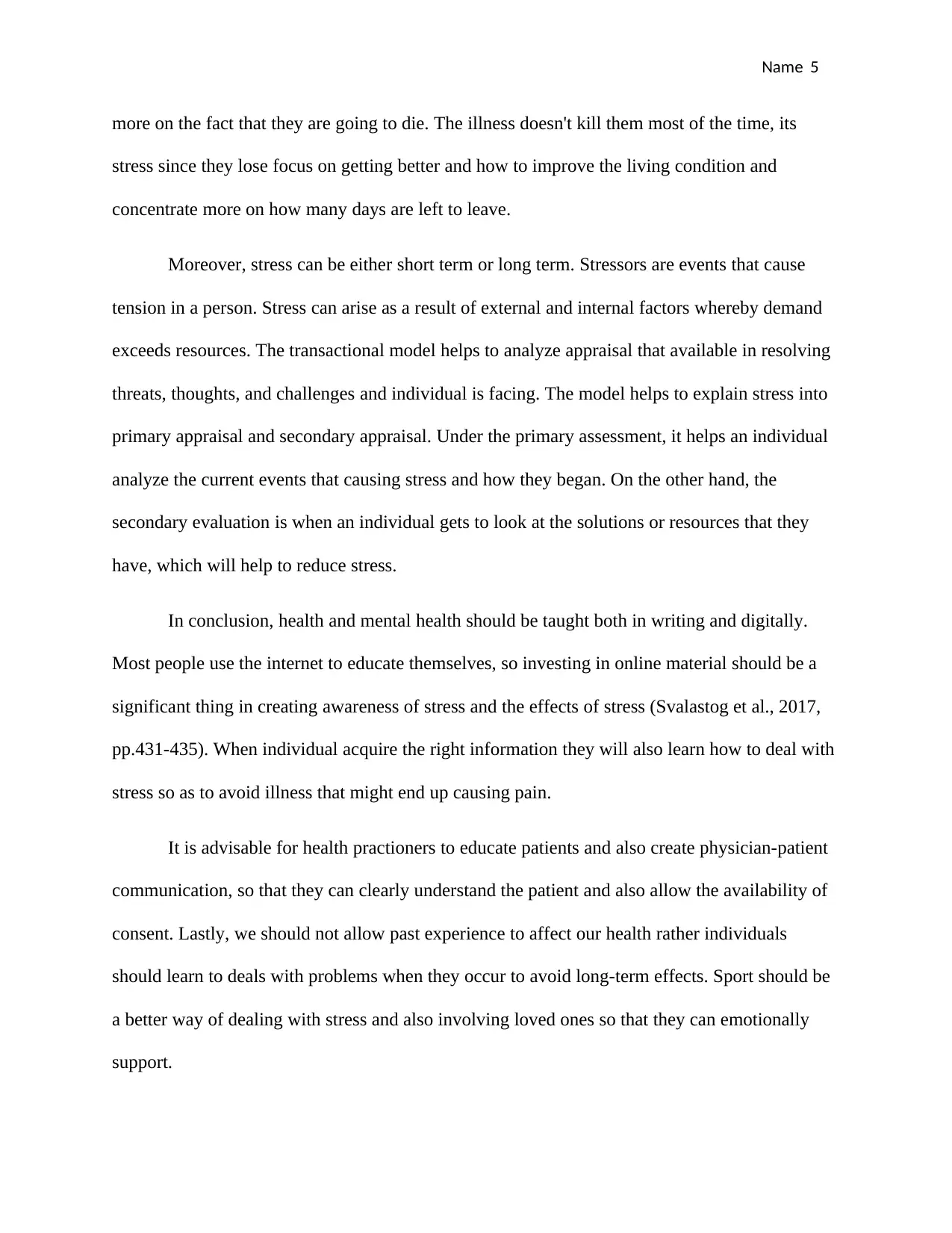
Name 5
more on the fact that they are going to die. The illness doesn't kill them most of the time, its
stress since they lose focus on getting better and how to improve the living condition and
concentrate more on how many days are left to leave.
Moreover, stress can be either short term or long term. Stressors are events that cause
tension in a person. Stress can arise as a result of external and internal factors whereby demand
exceeds resources. The transactional model helps to analyze appraisal that available in resolving
threats, thoughts, and challenges and individual is facing. The model helps to explain stress into
primary appraisal and secondary appraisal. Under the primary assessment, it helps an individual
analyze the current events that causing stress and how they began. On the other hand, the
secondary evaluation is when an individual gets to look at the solutions or resources that they
have, which will help to reduce stress.
In conclusion, health and mental health should be taught both in writing and digitally.
Most people use the internet to educate themselves, so investing in online material should be a
significant thing in creating awareness of stress and the effects of stress (Svalastog et al., 2017,
pp.431-435). When individual acquire the right information they will also learn how to deal with
stress so as to avoid illness that might end up causing pain.
It is advisable for health practioners to educate patients and also create physician-patient
communication, so that they can clearly understand the patient and also allow the availability of
consent. Lastly, we should not allow past experience to affect our health rather individuals
should learn to deals with problems when they occur to avoid long-term effects. Sport should be
a better way of dealing with stress and also involving loved ones so that they can emotionally
support.
more on the fact that they are going to die. The illness doesn't kill them most of the time, its
stress since they lose focus on getting better and how to improve the living condition and
concentrate more on how many days are left to leave.
Moreover, stress can be either short term or long term. Stressors are events that cause
tension in a person. Stress can arise as a result of external and internal factors whereby demand
exceeds resources. The transactional model helps to analyze appraisal that available in resolving
threats, thoughts, and challenges and individual is facing. The model helps to explain stress into
primary appraisal and secondary appraisal. Under the primary assessment, it helps an individual
analyze the current events that causing stress and how they began. On the other hand, the
secondary evaluation is when an individual gets to look at the solutions or resources that they
have, which will help to reduce stress.
In conclusion, health and mental health should be taught both in writing and digitally.
Most people use the internet to educate themselves, so investing in online material should be a
significant thing in creating awareness of stress and the effects of stress (Svalastog et al., 2017,
pp.431-435). When individual acquire the right information they will also learn how to deal with
stress so as to avoid illness that might end up causing pain.
It is advisable for health practioners to educate patients and also create physician-patient
communication, so that they can clearly understand the patient and also allow the availability of
consent. Lastly, we should not allow past experience to affect our health rather individuals
should learn to deals with problems when they occur to avoid long-term effects. Sport should be
a better way of dealing with stress and also involving loved ones so that they can emotionally
support.
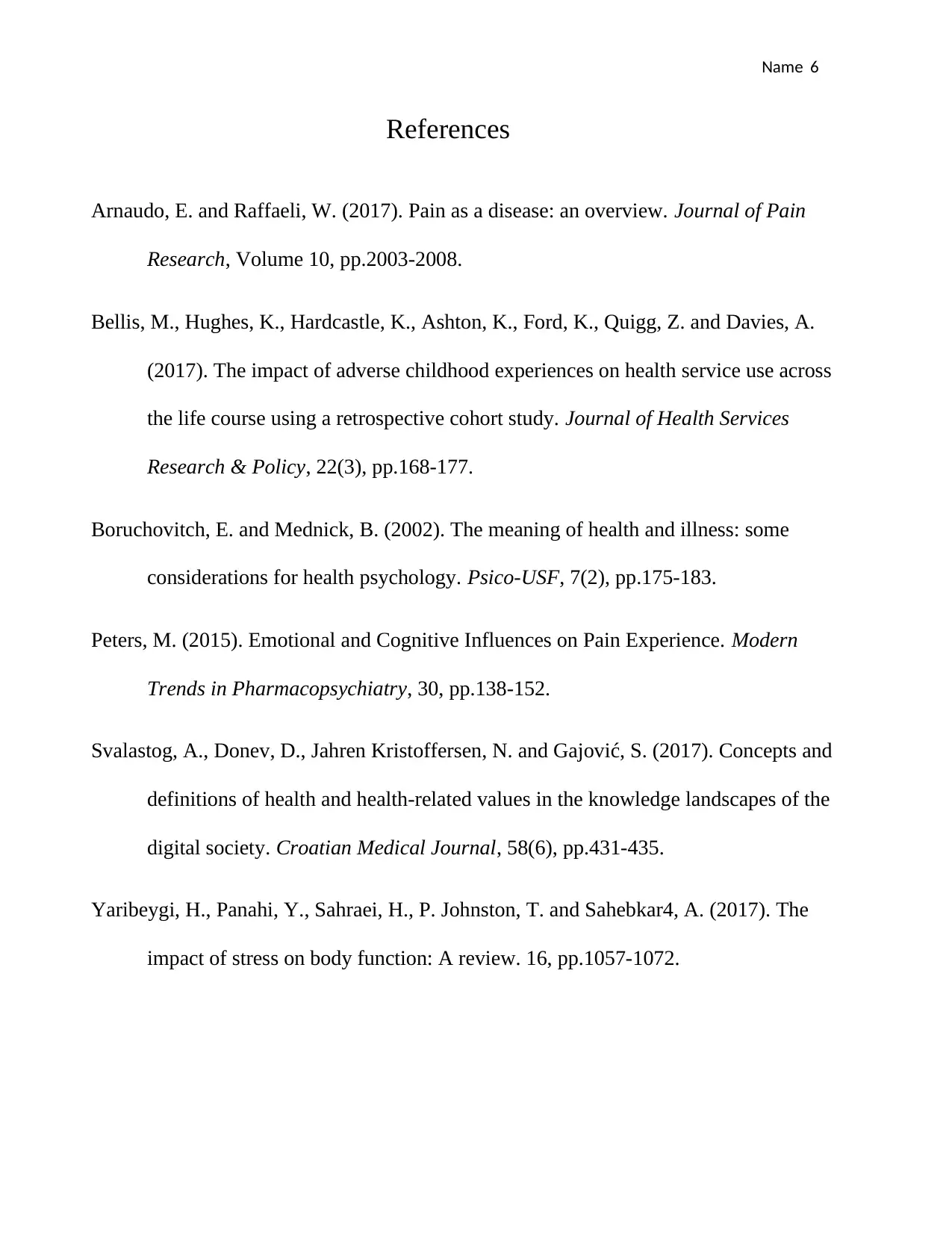
Name 6
References
Arnaudo, E. and Raffaeli, W. (2017). Pain as a disease: an overview. Journal of Pain
Research, Volume 10, pp.2003-2008.
Bellis, M., Hughes, K., Hardcastle, K., Ashton, K., Ford, K., Quigg, Z. and Davies, A.
(2017). The impact of adverse childhood experiences on health service use across
the life course using a retrospective cohort study. Journal of Health Services
Research & Policy, 22(3), pp.168-177.
Boruchovitch, E. and Mednick, B. (2002). The meaning of health and illness: some
considerations for health psychology. Psico-USF, 7(2), pp.175-183.
Peters, M. (2015). Emotional and Cognitive Influences on Pain Experience. Modern
Trends in Pharmacopsychiatry, 30, pp.138-152.
Svalastog, A., Donev, D., Jahren Kristoffersen, N. and Gajović, S. (2017). Concepts and
definitions of health and health-related values in the knowledge landscapes of the
digital society. Croatian Medical Journal, 58(6), pp.431-435.
Yaribeygi, H., Panahi, Y., Sahraei, H., P. Johnston, T. and Sahebkar4, A. (2017). The
impact of stress on body function: A review. 16, pp.1057-1072.
References
Arnaudo, E. and Raffaeli, W. (2017). Pain as a disease: an overview. Journal of Pain
Research, Volume 10, pp.2003-2008.
Bellis, M., Hughes, K., Hardcastle, K., Ashton, K., Ford, K., Quigg, Z. and Davies, A.
(2017). The impact of adverse childhood experiences on health service use across
the life course using a retrospective cohort study. Journal of Health Services
Research & Policy, 22(3), pp.168-177.
Boruchovitch, E. and Mednick, B. (2002). The meaning of health and illness: some
considerations for health psychology. Psico-USF, 7(2), pp.175-183.
Peters, M. (2015). Emotional and Cognitive Influences on Pain Experience. Modern
Trends in Pharmacopsychiatry, 30, pp.138-152.
Svalastog, A., Donev, D., Jahren Kristoffersen, N. and Gajović, S. (2017). Concepts and
definitions of health and health-related values in the knowledge landscapes of the
digital society. Croatian Medical Journal, 58(6), pp.431-435.
Yaribeygi, H., Panahi, Y., Sahraei, H., P. Johnston, T. and Sahebkar4, A. (2017). The
impact of stress on body function: A review. 16, pp.1057-1072.
⊘ This is a preview!⊘
Do you want full access?
Subscribe today to unlock all pages.

Trusted by 1+ million students worldwide
1 out of 6
Related Documents
Your All-in-One AI-Powered Toolkit for Academic Success.
+13062052269
info@desklib.com
Available 24*7 on WhatsApp / Email
![[object Object]](/_next/static/media/star-bottom.7253800d.svg)
Unlock your academic potential
Copyright © 2020–2025 A2Z Services. All Rights Reserved. Developed and managed by ZUCOL.





